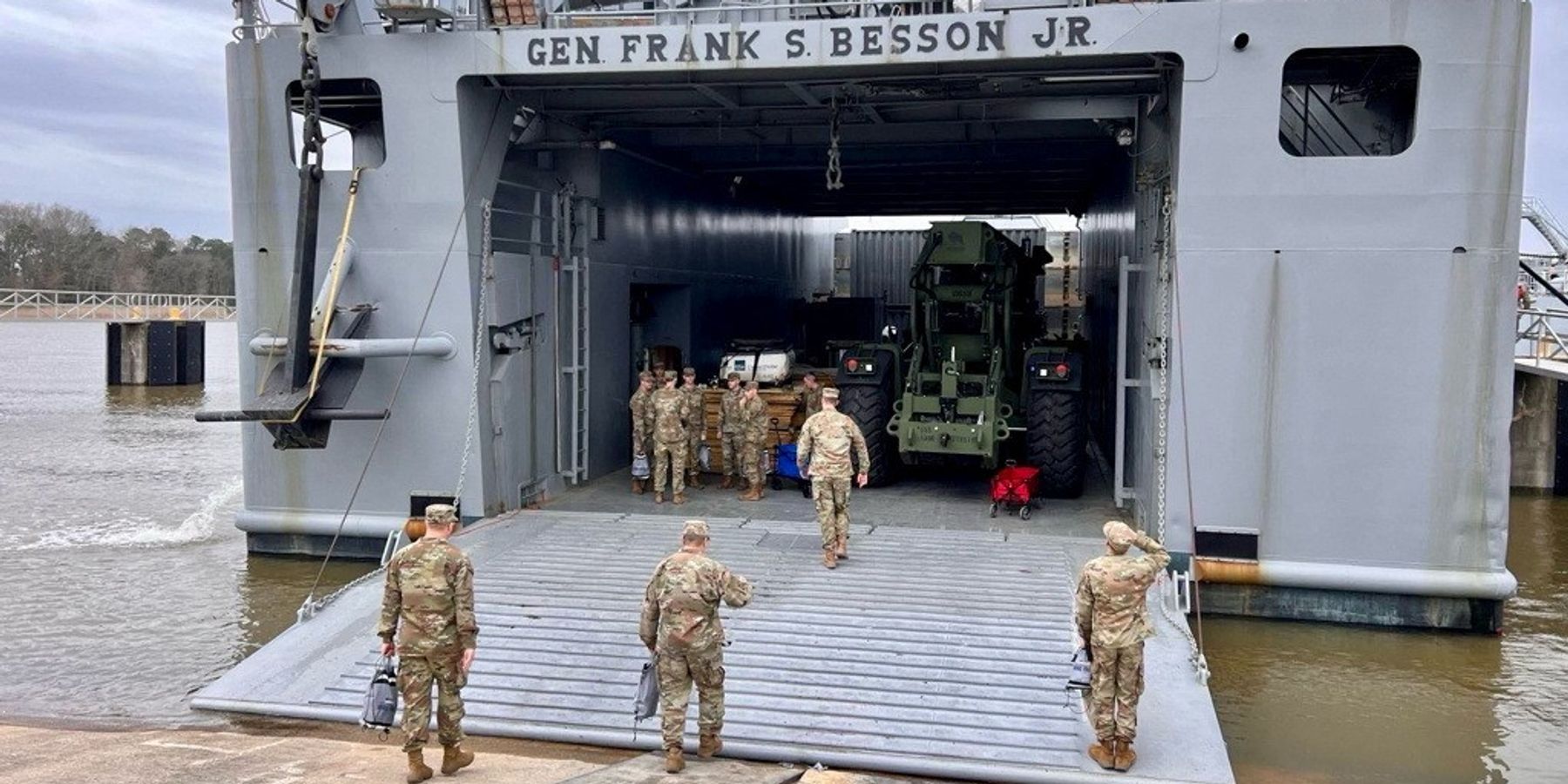The Pentagon’s plan for floating piers and a causeway to surge humanitarian aid into Gaza is drawing fire from military experts for its lack of detail, potential danger to U.S. troops, and risk of mission creep. Bottom line, it’s a bit of a head-scratcher.
“Biden is committing the United States military to conducting a highly complex, very expensive, low-production operation to bring food into the strip — when Biden could massively increase the amount of food into the strip with far less effort or expense: demand that Israel merely open the damn gates and roll the hundreds of trucks awaiting entry right now. Today,” exclaimed (Ret.) Lt. Col. Daniel Davis, senior fellow at Defense Priorities, in an exchange with RS.
“This is an absurd idea, on so many levels,” Davis added.
The Pentagon said Tuesday that five Army cargo and support ships have left their base at Fort Eustis, Virginia, to assist the building of “roll on-roll off pier capability” just off the Gaza shore in order to begin a mission of injecting “two million meals a day” into the starving strip. The efforts, as announced Friday, will take an estimated 60 days.
These massive ships will be able to carry the enormous amount of materials and personnel needed to construct what the Pentagon says will be a floating pier to which aid loaded at Cyprus will be taken. That aid, according to Pentagon spokesman Maj. Gen. Pat Ryder, will then be moved by Navy logistic support vessels to a floating causeway — about 1,800 feet long with two lanes and anchored to the beach of Gaza — that will also be constructed by the U.S. military as part of the mission.
Questions remain how the aid will get to the beach (the Pentagon insists it won't be via U.S. military) and to actual Gazans, given the intense Israeli security there, and ongoing shelling, bombings, and other combat activity inside the strip. As to the delivery and security questions, Ryder said in his Friday briefing that "we're continuing to plan and coordinate with partners in the region."
Much of the criticism about this plan points out that there there has been plenty of aid waiting at the borders already, but Israeli inspections and the lack of security — including incidents where Israel has been accused of attacking aid workers and Palestinians forming up for aid — has prevented critical deliveries.
According to reports Friday a new inspection process will supposedly take place in Cyprus, the starting point of a new maritime corridor just established by the U.S., United Arab Emirates, and European countries. This may have all been Bibi Netanyahu's idea (reportedly, based on a single source), but there has been no official confirmation from Israel that it has agreed to allow aid into Gaza from the beach.
Furthermore, this U.S. effort is expected to involve “more than 1,000 U.S. forces” — quite a fungible number — between the Army and Navy. Michael DiMino, a former career CIA military analyst and counterterrorism officer who is now a program manager at Defense Priorities, notes that Ryder did not have much to say Friday when asked about the potential vulnerability of troops, and how much role they might play in staging aid operations.
“It is a non-trivial concern that troops may come under attack,” by militants, particularly Hamas, DiMino said. “That is shocking to me that there is no real explanation about what the contingency plans are. How are we going to respond if our troops or government personnel come under attack?”
The hackles were raised when Ryder was asked two key questions in the DoD briefing room. One, if the U.S. has received assurances from Israel that it will not fire on Palestinians seeking to retrieve the aid, and the second, whether there is concern that U.S. troops could be fired upon by Hamas.
On the first, Ryder said, “look our focus is on delivering the aid, I’m not going to speak for the Israelis.” On the second, he said, “that’s certainly a risk, again if Hamas truly does care about the Palestinian people then one would hope that this international mission would be able to happen unhindered.”
DiMino says his “Spidey senses are tingling,” as there is “no such thing as zero risk.”
“I think the biggest potential problem is mission creep,” he said, noting we have no guarantee that this won’t go from “one pier to two piers, to beach head, to forward operating base — in for a penny, in for a pound.”
Ultimately, DiMino said, “you’ll now have a fixed U.S. presence in the warzone, in what is probably the most unstable place in the world right now."
He said the lack of detail from the Pentagon (Ryder said Tuesday that, for operational security reasons, they would not say exactly where the construction would take place) on the size, scope, and manpower, and most importantly, what the beach operation would look like and who would secure deliveries there, is raising serious questions.
The Wall Street Journal published an article Sunday that suggested that the administration was in talks with private contractors specializing in humanitarian aid missions in conflict zones. The one named is Fog Bow, which is run almost entirely by former U.S. military and intelligence officers, including Mick Mulroy, former Deputy Assistant Secretary of Defense for the Middle East under Trump, U.S. Marine, and 20-year veteran of the CIA. The administration has not yet entered into any formal arrangements, according to the paper.
Fog Bow has quite a bit of cross pollination with the Lobo Institute, a consulting firm which also counts former military and intelligence officials, along with diplomats and humanitarian experts, among its expert ranks. The institute says it advises on current wars and “how to end conflicts and prevent their recurrence, and how to help those most affected,” but it also provides tactical training “to prepare intelligence and special operations units for both current and future irregular warfare operations.”
Using private contractors to deliver the aid from causeway to beach and beyond could be a gambit to put a “non-military face” on these military operations, as (Ret.) Col. Doug Macgregor points out to RS, and there are plenty of former Special Operations forces ready to earn a paycheck. It was also suggested in the WSJ article that Fog Bow has already offered to begin delivering aid by sea before the pier is built and to start dredging a corridor on a “private beachfront” to allow barges to land close to shore.
The WSJ also confirmed that the Qatari government has already offered $60 million for Fog Bow's efforts. This begs the question of how much this has already been spelled out and greenlighted, in addition to the ultimate cost to U.S. taxpayers. That angle has yet to be revealed, but considering the heavy lift of ships, materiel, fuel and labor, this is going to run into the hundreds of millions, at least, say experts.
Lt. Col. Davis said he is incensed with what he said is a needless burden and potential risks. “Instead of using the powerful leverage we have — plane-loads of military kit and ammunition daily to Israel and diplomatic resources at the UN Security Council — Biden is leaving all the tools unused and is instead allowing (Israeli prime minister Benjamin) Netanyahu to fully run the show, and Biden is spending millions of American dollars and diverting U.S. military assets to do what Netanyahu could do for free."
“It is shameful at every level,” he added. “There's nothing good for the U.S. in this, and it won't even do much to alleviate the suffering of the Palestinians.”
- On air, Biden walks back his own Rafah 'red line' in real time ›
- SOTU: Biden's Gaza aid plan gets mid-to-tepid applause ›
- Alarming lack of detail in military's Gaza aid project | Responsible Statecraft ›
- Where are the US ships on the Gaza aid mission now? | Responsible Statecraft ›
- Military pier project in Gaza could be 'on ice' | Responsible Statecraft ›
- Could the maritime corridor become Gaza’s lifeline? | Responsible Statecraft ›
- Staging ground for US military aid pier in Gaza attacked | Responsible Statecraft ›
- It's May, where is the US military's $320M pier project? | Responsible Statecraft ›
- By the numbers: US Gaza pier project appears sunk | Responsible Statecraft ›
- Israel to use US military contractors in new Gaza aid scheme | Responsible Statecraft ›
















